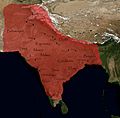History of Islam facts for kids
Muslim history started in Arabia when Muhammad shared the Quran in the 7th century. The story of Islam has shaped political, economic, and military events both within and outside the Islamic world.
Just like with Christianity, thinking about an Islamic world helps us understand different times in human history.
Contents
The Start of Muslim History
After Muhammad passed away, Abu Bakr became the leader of the Muslims. He was followed by Umar, Uthman ibn Affan, and then Ali. These four leaders are known as the Rashidun Caliphs. This means "The Righteous Caliphs." A caliph was a very important religious and spiritual leader.
Under these caliphs, Islam grew to be one of the most important religions in the Middle East. They set up offices to help run the Muslim nation. During Umar's time, Muslims conquered more than two-thirds of the Eastern Roman Empire. Umar also started the Muslim calendar.
Early Conflicts: The First Civil War
What Was the First Fitna?
The first major conflict in Islam, called the First Fitna, happened during the rule of the fourth caliph, Ali. It lasted throughout his time as leader. The third caliph, Uthman ibn Affan, had been killed by rebel Muslim groups who had political reasons for their actions.
When Ali became caliph, his biggest challenge was to punish those responsible for Uthman's murder. However, many people felt that Ali should have focused on finding and punishing the killers before accepting the role of caliph.
The Battle of the Camel
A group of people, led by Muhammad's wife Aisha and her relatives Talhah and Zubair ibn al-Awam, did not accept Ali as caliph. They gathered an army and met Ali's army near Basra in Iraq. They originally planned to talk things out.
However, during the night, some fighting began. This might have been due to confusion or because rebel groups involved in the murder started it. This led to the Battle of Bassorah, also known as the Battle of the Camel. Ali's side won this battle. After the fight, Ali respectfully sent Aisha back to Medina.
Challenges to Ali's Leadership
Even after this battle, tensions remained high in the Muslim empire. Soon, Ali was challenged by Muawiyah, who was the governor of the Muslim provinces in Syria. Muawiyah also demanded that Uthman's murderers be punished. He refused to accept Ali as caliph until this issue was resolved.
Muawiyah was a relative of Uthman. His army promised to bring the murderers and those who protected them to justice. This was a hint towards Ali and his followers. The two groups met and fought in a battle called the Battle of Siffin. This battle ended in a tie, so both sides agreed to try to settle things through talks. However, these talks did not lead to a clear decision.
The Kharijites and Ali's Death
Meanwhile, another group of Muslims called The Kharijites had been with Ali before. But they later turned against him. They felt that Ali was not following true Islam and was treating the caliphate as his own property.
In the years that followed, Ali's governors could not stop him from losing control of some provinces to Muawiyah. Muawiyah grew stronger by making his army bigger. Ali had moved the capital of the caliphate from Medina to Kufa in 656 CE. Sadly, a Kharijite assassin killed Ali in Kufa in 661 CE.
Images for kids
-
Close-up of a page from the Birmingham Quran manuscript.
-
Empire of the Rāshidūn Caliphate at its peak under the third caliph ʿUthmān (654 CE) Strongholds of the Rāshidūn Caliphate
-
Territories of the Umayyad Caliphate
-
Abbasid caliphate in the 850s
-
Gold dinar of Abbasid caliph Al-Mansur.
-
Gold dinar of Abbasid caliph al-Mu'tasim.
-
Goharshad Mosque built by the Timurid Empire.
-
Tamerlane chess, invented by Amir Timur.
-
Map of the Mamluk Sultanate (in red) and the Mongol Ilkhanate (in blue) (1250–1382)
-
The Great Mosque of Kairouan in Tunisia.
-
Qutub Minar, the world's tallest brick minaret.
-
Grand Mosque of Demak, Java.
-
Osman I, founder of the Ottoman Empire.
-
The Süleymaniye Mosque in Istanbul.
-
The Safavid Empire at its greatest extent under Shah Ismail I (1501-1524).
-
Mughal India at its greatest extent.
-
Taj Mahal, a mausoleum built by Mughal Emperor Shah Jahan.
See also
 In Spanish: Historia del islam para niños
In Spanish: Historia del islam para niños




































